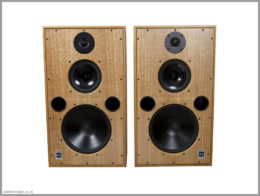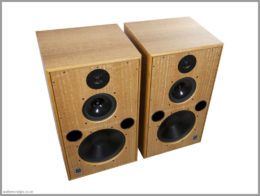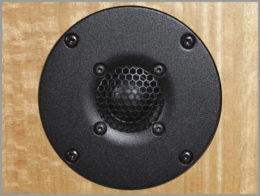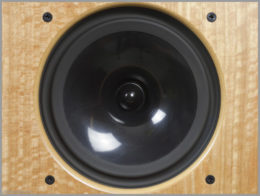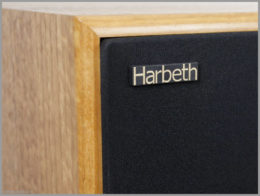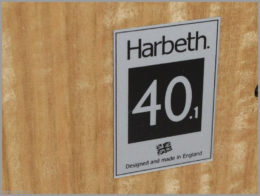TABLE OF CONTENTS
MY STORY WITH HARBETH M40.1
If you have read any articles on this website, you’ll know that I have a soft spot for large and heavy speakers. It wasn’t until I experienced the sound of Harbeth, when I realised that loudspeakers don’t have to be big and weight a ton, to provide quality sound and an immersive listening experience. Since then, I have become more open minded about the design of speakers and had happily settled down with a pair of Harbeth M30.1. However, old habits die hard, and I started wondering… if I am so happy with the relatively small M30.1, how much happier could I be with the largest speakers in the Harbeth range – the Monitor 40.1? Unfortunately none of the local HiFi stores had these available for demo, thus I begun reading reviews and browsing various forums to get a gist of what sort of sound I could expect from the Harbeth M40.1. My interest in these speakers also correlated with the release of the Harbeth M40.2, which meant that finding a set of M40.1 was rather difficult.
I had to wait a while, but I eventually stumbled across a set of the M40.1s in the HiFi Corner store in Edinburgh, Scotland. These were priced significantly cheaper than the M40.2s and I decided to buy them without auditioning… Due to the value I decided to pick them up in person, however, after checking my sedan car with a tape measure, I discovered that collecting them in person in the vehicle I had was certainly not an option. I had to ask a good friend to come with me in his hatchback car. I took a total of 10h to get there and back, however, the long journey was worth it and I ended up with a great set of Harbeth M40.1 speakers. Was it a good decision? Read on…
SPEAKER INFO
Model History
The Monitor 40 line was launched in 1998 as a direct replacement of the BBC’s flagship design – LS5/8 studio monitors. The LS5/8 was a 2 way design, whereas the M40 was a 3 way design, with a 25mm Seas dome tweeter, 200mm Harbeth RADIAL midrange driver and 300mm Vifa woofer. Although it was designed with acoustically treated studios in mind, the Monitor 40 received very positive feedback within the domestic market. If there was one thing that domestic users did not like, it was the amount of bass, which in non-optimised domestic environments could be quite overwhelming. Around 2006, Vifa – the supplier of the 300mm bass driver – stopped making it without any notice. Harbeth decided to design and build their own 300mm bass driver. Instead of making a clone of the Vifa driver, a decision was made to create a driver that would address the M40’s bass issues reported by some of the domestic users. Harbeth also took this opportunity to improve the midrange driver by using the newly developed RADIAL2 diaphragm, adding a higher impedance voice coil and increasing the flux. These changes lead to Harbeth having to redesign the crossover from the ground up. And this is how the Harbeth M40.1 was born… The original M40 was available for sale until 2007, and was replaced by the M40.1 in 2008.
Harbeth M40.1 sit at the top of Harbeth loudspeaker range. They feature Harbeth’s 300mm polypropylene woofer and 200mm midrange unit, with the diaphragm made of a special blend of injection moulded polypropylene (patented by Harbeth and referred to as RADIAL2) as well as a Seas tweeter from their high-end Excel range, produced to Harbeth specification.
As with other Harbeth speakers, the M40.1 are optimised for use away from walls and with tweeters at ear level.
Thin Wall Cabinet Design
Despite their rather large size, the Harbeth M40.1 feature the same thin wall design principle as their smaller models. The idea behind this design can be traced back to the 1950s BBC R&D department. Due to the increase in number of outside BBC broadcasts, there was a need for lighter monitor speakers. The reduction in weight could be achieved by using thinner cabinet walls and this is what began the BBC’s research program in this area. One of the factors that can have a significant impact on the loudspeaker sound is the enclosure, and more specifically, enclosure resonances. There are two philosophies when it comes to tackling this problem. The first one, and adopted by most loudspeaker manufacturers, attempts to make the cabinets as ridged as possible to prevent cabinet resonance. This is achieved by creating enclosures with thick walls and internal bracing. The second approach, developed by BBC, accepts that enclosure resonance cannot be completely dampened, thus it is better to move said resonance to a lower, less critical frequencies and reduce the amplitude. This is achieved by using thin walls which resonate at lower frequencies, with bitumen material attached internally which reduces the amplitude of these resonances. In addition, to further reduce rigidity of the cabinet, front and rear baffles are screwed on instead of being an integral part of the cabinet. Great analogy for this solution is a bell. A perfectly cast bell will ring on for a number of seconds, whereas a bell with a crack will hardly ring at all. In the speaker enclosure case, the crack is the connection between the main cabinet body and the front and rear baffles. A very clever and elegant solution if I may say.
The first design philosophy (if not correctly implemented) may result in cabinets that don’t resonate in bass frequencies, but due to their rigidity resonate at higher frequencies, that our ears are more sensitive to. In contrast, the second design philosophy may result in cabinets that are resonance free in the critical midrange frequencies, but exhibit some low amplitude resonance in the bass which our ears are less sensitive to.
HARBETH M40.1 SPECS
| Frequency Response: | 35 – 20,000Hz (+/- 3dB) |
| Sensitivity: | 84dB (1W input, measured at 1m) |
| Impedance: | 6Ω |
| Power Handling: | 200W |
| High Frequency Driver: | Seas 25mm Soft Dome Tweeter |
| Mid Frequency Driver: | Harbeth 200mm RADIAL2™ Cone Midrange |
| Low Frequency Driver: | Harbeth 300mm Cone Woofer |
| Crossover Frequencies: | Unknown |
| Enclosure Type: | Bass Reflex |
| Enclosure Dimensions (HxWxD): | 750x432x400mm (29.5x17x15.7″) |
| Weight: | 34kg (each speaker) |
| Production Year: | 2008 – 2017 |
| Price When Launched: | £10,000 |
LOOK & FEEL OF HARBETH MONITOR 40.1
The thin walls are made of MDF, veneered on both sides. The veneer on each enclosure is matched, and then both enclosures are matched with each other. The cabinet is finished with a thin layer of satin varnish, due to which, the wood texture can be seen and felt – I really like that. There is a single set of gold plated binding posts – nothing fancy but it shows the down-to-earth approach of the designer. The grills are made of a thin metal frame with fabric stretched over it. The frame slides into a narrow grove in the front panel of the speaker and it is held there by friction. Clever design because it prevents side reflections that you may find in more traditional grilles. Also, in contrary to smaller Harbeth speakers, the grilles of the M40.1 are fairly easy to remove, thus no issues from a usability point of view.
All 3 drivers, the Seas tweeter, Harbeth midrange unit and Harbeth woofer appear to be very well made. The crossover is rather complicated and features 37 elements! It appears to be made of decent quality components, but you will not find huge film capacitors or large air-core inductors here.
If I was to criticise anything, it would be to do with attention to details inside the cabinet. When I inspected mine, I noticed that the glue around the bass reflex ports did not go around the whole perimeter of the ports. I noticed a couple of spots that were missed in the harder to reach areas. Moreover, when I inspected the octagonal enclosure of the midrange unit, I discovered that its MDF walls were split by the screws that hold the back plate – could easily be avoided if the pilot holes were of a larger diameter. These things should have no impact on the sound whatsoever, however, with my pedantic nature I find it a little disappointing to see this in a £10k loudspeaker. I appreciate that these are not visible unless you open the cabinet and this would be absolutely fine if Harbeth M40.1 was not a premium product. There is a reason why an Aston Martin’s engine bay looks as impressive as the rest of the car… Because when you are buying something with this kind of pedigree and price, you expect to find a premium finish inside and out, even in the places you wouldn’t normally look. On the other hand, Harbeth are known for their down-to-earth engineering approach, i.e. if it does not improve the sound, then why bother? I mostly agree with this approach, yet a small part of me wishes that the cabinets on the inside had greater attention to details.
Nonetheless, Harbeth Monitor 40.1 are very beautiful loudspeakers to look at if you don’t mind the size. In reality, they look much bigger and much more imposing than on the photos – and this is coming from a guy who had Tannoy GRF in his living room. I was a little surprised after placing the speakers in my living room and quite concerned as to how my wife would react on seeing them for the first time. Initially I did not like them with the grilles on, but over time they have grown on me, and I now like them equally with and without the grilles. This is good because the speakers where designed, measured and tuned with the grilles on, and this is how they were supposed to be listened to according to their designer, Mr Alan Shaw.
SOUND OF HARBETH M40.1 SPEAKERS
First Impressions
As is often the case with HiFi, expectation can exceed reality, especially if we take into account diminishing returns. I had never heard Harbeth M40.1 before and every review I read was rather positive. I had great expectations but I did not quite know what to expect. It is one thing to read about how something sounds and another to actually listen to it yourself.
When I put the M40.1 next to my M30.1 and did a side by side comparison, I wasn’t blown away. The M40.1 had significantly more low end extension, sounded more full-bodied but also seemed less airy, which initially made them sound less involving. Over the years, experience has taught me not to jump to conclusions, thus I put my Harbeth M30.1 away and setup the Harbeth M40.1 in the correct position.
Bass
After auditioning all other models in the Harbeth range, I had expectations of quality bass with plenty of details and good impact. The M40.1s did not disappoint in this area. The bass is rich in details and the 12in bass drivers move enough air to make you not only hear the bass but also feel it with your body. The kind of effortless ‘oomph’ sound that can be felt in your chest. Sure, they don’t have the kick of big JBL loudspeakers with 18in bass drivers, but the attack they have is perfectly sufficient and will meet or exceed the needs of most home users. In terms of depth of the bass, when needed, they go way lower than all other speakers in the Harbeth range. I actually did not appreciate how much information is in the lower registers and how much I have been missing until I experienced these Harbeth M40.1. I was blown away when I played Loneliness House by Greg Brown – it was by far the best reproduction of this track in my room to date; with great attack, plenty of details and fantastic vocals. What concerned me before getting a set of these was the amount of bass. The M30.1 with tracks such as I Want You Back by Lake Street Drive where a double bass is being played, excited standing waves in my room, making some of the bass notes appear boomy. I was concerned that the M40.1 would make this even worse. Imagine my surprise when during a side by side comparisons, the problematic bass notes sounded perfectly fine on the M40.1 but slightly boomy on the M30.1s. It appears that the Harbeth M40.1 are more linear in the bass area than the M30.1, or it maybe to do how these speakers interact with my room. My listening room is just over 21m2 and the M40.1 did not create any bass issues here. Based on this experience and providing that the speakers are placed away from the rear and side walls, they should not casue any issues with bass in medium size rooms.
Midrange, Treble, and Soundstage
But enough about bass. Let’s talk about the midrange and treble as these are the areas that Harbeth speakers are well know for. I would say that out of the whole Hatbeth range, the M40.1 have most in common with M30.1s, with the voicing towards the warmer side of natural. Strangely though, the tone of vocals is different, with less emphasis on ‘ts’ sibilants and more natural open sound. Whenever I had people over and played both speakers side by side, the first impression was always that the ‘voices sound better on the big speakers’. I would agree with it, but at the same time I’d like to point out that there is absolutely noting wrong with the sound of vocals on the M30.1. In my opinion, where the M40.1 shine is how they separate sounds from each other. They seem to be able to create clearly defined depth layers with different instruments and vocals coming from different depths behind the speakers – very nice. On the other hand, their even-handed sound means that string instruments such as guitars don’t seem to have have as much attack and sharpness as on some large Dual Concentric Tannoy speakers that I previously experienced. However, the advantage of this type of balance means that the body of the string instrument is presented in a more realistic way. If you prefer a more airy sound with more top end spark, perhaps the newer Monitor 40.2 or SHL5 Plus would be better suited to your taste. The warmth of the Harbeth Monitor 40.1 benefits reproduction of brass instruments and makes them appear more life-like. I absolutely love tracks such as My Romance by Ben Webster playing through these speakers. Clapping sounds very real too, which further enhances the 3D sound stage illusion that these speakers are so good at creating. Out of all the speakers I have heard so far, the M40.1 create the most impressive soundstage illusion. It always takes me by surprise when I play a track that I always perceived as flat, and when played through the M40.1 it becomes more three dimensional. I honestly don’t know how this works but I like it a lot!
One of he biggest advantages of the M40.1 is their full-bodied sound and their tonal balance. The initial impression of them not sounding as airy the M30.1s actually works in their favour. Let me explain… there are a number of songs that I really like, however, they are mixed in a way that makes them sound flat and light on most setups. A good example of this would be Everywhere by Fleetwood Mac. I always liked the song but always felt that it did not have enough bottom end extension and attack, which often resulted in me turning up the volume. Once I was happy with the bass extension and attack, the song was so loud that the vocal sounded ear piercing. The M40.1 are one of the very few speakers which I could actually listen to this song at a moderate level and not feel that I am missing anything. They have sufficient bass, decent kick and balanced sound.
The combination of low end extension, great attack, sublime vocals, full bodied sound and three dimensional soundstage make the Harbeth M40.1 speakers very special. When I played Jangalene from the Naked Truth album by Golden Earring, this combination of traits turned it into a quite spectacular experience in my living room. I have not previously heard this album sounding so dynamic, engaging, and so 3 dimensional. I actually though that I was fooling myself, so I ran to another room and brought back the M30.1 for comparison. And, although the sound wasn’t bad, it definitely wasn’t the sound of the M40.1s!
Final Thoughts
A lot of high end speakers tend to concentrate on the perceived clarity over the naturalness. This results in speakers that sound impressive only with well recorded music. I remember auditioning Wilson Audio Alexia playing Ne Kuni Me Ne Ruzi Me Majko by Ljiljana Buttler and being quite astounded. I remember then coming back home and playing the same tack on the Harbeth Monitor 40.1 and thinking to myself that it does not sound as sharp or as impressive. On the other hand I remember listening to normal quality recordings on a ‘high end’ system and thinking to myself that I could not listen to it for more than a couple of minutes. The point I’m trying to make here is that Harbeth, in contrary to a lot of modern high end brands, tend to voice their speakers so they are more forgiving and easier to listen to, more right if you will. This does not mean that you loose any details – these are still there, just not forced upon you. Don’t get me wrong, Harbeth speakers are not going to fix bad recordings, but they are not going to emphasise their shortcomings during listening sessions. Moreover, because of their ability to create a deep soundstage, they are likely to make flat sounding tracks more engaging to listen. A good example of that would be the Busted Stuff album by Dave Matthews Band. In contrast to all other Dave Matthews Band albums, it always sounded flat and not engaging. This was the reason why I rarely listened to it. Very disappointing as I really liked the songs on this album. This changed when I listen to it for the first time through Harbeth M40.1. All of the sudden, the extra weight at the bottom combined with soundstage depth, made this album a lot more listenable. It is still not a reference quality by any standards, but it is good enough for me to enjoy it.
If you are considering a pair of Harbeth Monitor 40.1 or any other Harbeth speakers for this matter, make sure you can give them enough listening time, ideally in your home environment. If you just pop over into a HiFi store and listen to them side by side against other speakers, you will most likely not be able to appreciate what they offer.
To conclude – if you are tired of swapping and changing your HiFi in pursuit of better sound, Harbeth M40.1 may actually be the very last speakers you will ever need to buy. Sure, there are other speakers that may excel in various areas, however, I have not found one yet that would be so good at so many things. Needles to say, I have made a good decision, and I have a feeling that I will be keeping these for a while.
CONCLUSION
Harbeth M40.1 speakers are very well-balanced, full bodied and natural sounding speakers. Exceptional midrange clarity and very impressive bottom end extension and dynamics. Capable of creating a three-dimensional soundstage that very few speakers can. Never fatiguing, can be enjoyed for hours. All of these qualities add up to a very immersive and engaging listening experience. If money isn’t an obstacle, it would be hard to find another speaker that is so good at so many things.
| Balance of Sound: | |
| Neutrality of Tone: | |
| Transparency: | |
| Soundstage: | |
| Attack: | |
| Engagement: | |
| Total Score: |
SONGS MENTIONED IN THIS REVIEW
Ben Webster – My Romance
Fleetwood Mac – Everywhere
Golden Earring – Jangalene (Unplugged)
Greg Brown – Loneliness House
Lake Street Drive – I Want You Back
Ljiljana Buttler – Ne Kuni Me Ne Ruzi Me Majko
Reviewed: June 2019 | Published: November 2019


